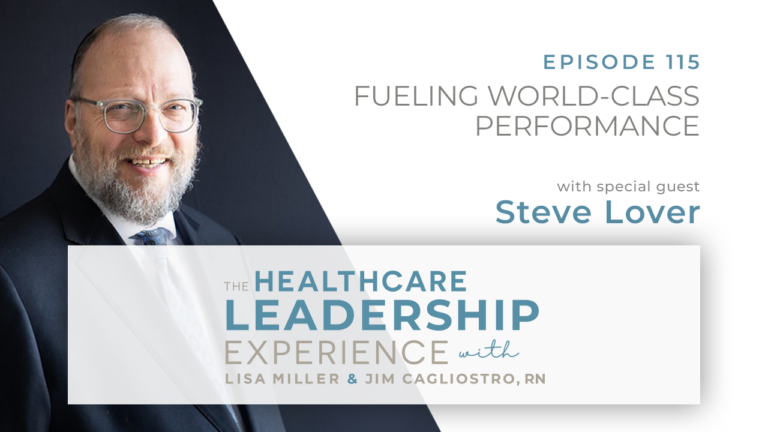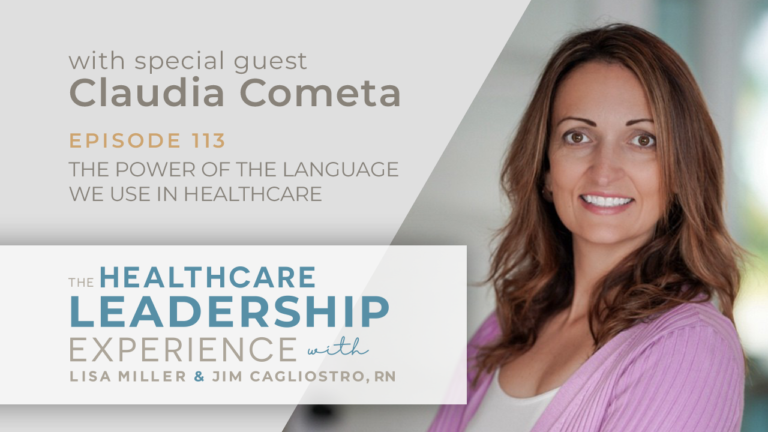In Episode 16 of The Healthcare Leadership Experience, Lisa is joined by Lisa her producer Lisa Larter, from The Lisa Larter Group. Together they discuss the importance of creating an engaged healthcare organization with a cost conscious culture.
As Lisa Larter observes, ‘’… imagine if you could somehow take the patient’s cost conscious mindset and infuse that into the culture of the entire organization, so that the patient and the healthcare provider are both on the same page.’’
This episode is sponsored by VIE Healthcare Consulting® which has proudly helped hospitals save $758 million since 1999.
In today’s episode you’ll hear:
Why vision, visibility and value are the three pillars of an engaged and cost conscious healthcare organization – and why a cost conscious mindset isn’t as intuitive as health organizations might believe.
The four ways to create an engaged organization and why it matters. (Hint: the high levels of unnecessary waste are a big factor in this issue).
Why every hospital should be having open conversations about cost now ‘’…questioning cost should be the norm and not the exception. Every person in the organization should be invited to question the cost of things that are happening on a day to day basis.’’
Why your non-labor costs is the first area for healthcare organizations to look for cost savings.
The importance of mindset in the face of rising inflation as we move into 2022. ‘’… if you have the mindset, there’s nothing we can do, ….you’re going to be victim to inflationary costs … I’m going to tell you that there are things you can do.’’
The vital role of frontline employees in a cost conscious healthcare organization.
Learn more vital strategies to create and nurture culture in healthcare with former hospital COO now Values Coach Joe Tye in Episode 4 of The Healthcare Leadership Experience.
CLICK HERE TO DOWNLOAD THE PDF TRANSCRIPT
Connect with Lisa:
📱https://www.linkedin.com/in/lisamiller/
CLICK HERE TO OPEN THE FULL TRANSCRIPT
Lisa Miller (00:00):
I think it takes a deliberate approach, it doesn’t happen naturally. And I think we automatically assume everyone in the organization is cost-conscious and I think it takes some planning, it takes some deliberate conversations. An engaged healthcare organization has three parts. It has vision, visibility and value. You know, it’s a CEO, CFO, COO, has to give the purpose, the vision, mission and the why. If you have the mindset, there’s nothing we can do, then you’re going to be victim to the inflationary costs. You’re going to be victim to the vendors coming in and just telling you what the increases are.
Lisa Larter (00:40):
It’s not the CFO that’s going to notice that the sizing changed, it’s the frontline worker that’s going to notice. And that’s where your whole point about creating that cost-aware environment, that cost-conscious cause is so important.
Speaker 3 (00:56):
Welcome to the Healthcare Leadership Experience, a place where healthcare leaders will share proven strategies and innovative approaches to leading the clinical and business side of healthcare. This show is sponsored by VIE Healthcare Consulting, who’s proudly helped hospitals save over $700 million in non-labor costs since 1999. Here’s your host, Lisa Miller, founder and CEO of VIE Healthcare.
Lisa Miller (01:19):
Welcome to the Healthcare Leadership Experience. Today’s episode is the Engaged Healthcare Organization, and we’re going to be speaking about costs and how to engage your healthcare organization. I’d like to welcome Lisa Larter, our producer for the show today. Welcome, Lisa.
Lisa Larter (01:37):
Thanks for having me. I’m looking forward to doing this with you.
Lisa Miller (01:40):
Yes, this is going to be fun. So I want to start talking about the healthcare organization, how it’s important to have an engaged organization and really to have a culture of cost consciousness. You know, many people in their personal lives have a cost-conscious mindset, right? In our personal lives where we’re looking at costs and just think it’s the same aspects of what we do in our personal life and engaging your healthcare organization and having a cost-conscious mindset. And I think it takes a deliberate approach, doesn’t happen naturally.
And I think we automatically assume everyone in the organization is cost-conscious and I think it takes some planning, it takes some deliberate conversations. And part of our work is a program we call Cost Aware for Patient Care, but I’m going to talk to you about that on future episodes. But really today, how do we get this engaged healthcare organization? And, you know, Lisa, what do you think about engaging any company, but particularly healthcare organizations on having this mindset of being cost-conscious?
Lisa Larter (02:54):
Well, it, it’s interesting because I am not from the healthcare industry, but I learned a lot about the healthcare industry and conversations with you. And the first thing that came to my mind when you started talking about cost conscious is the patient is cost conscious. And imagine if you could somehow take the patient’s cost-conscious mindset and infuse that into the culture of the entire organization so that the patient and the healthcare provider are both on the same page in terms of, you know, the quality and cost of healthcare being provided.
Lisa Miller (03:29):
And it’s a great point because, for just about everybody, we get copayment or we get some kind of bill or we get something afterwards that maps to the services of the care. So whether it’s 20% or could be more, 30%, you know, having that cost-conscious mindset does meet to where the patient meets, right? So the patient’s looking at the bill from a cost-conscious perspective, and it’s a great point. You know, we have a model and we’re going to talk about this model and also future episodes. But this model around having an engaged healthcare organization has three parts. It has vision, visibility and value. So the vision is how do you get everyone around cost savings and around a cost-conscious mindset and a goal? And again, we think it’s intuitive, but I don’t think it’s as intuitive as we would suspect.
So it’s the vision, it’s 2022 we have a big goal of taking out $10 million, taking out $20 million. And how do you get everyone around this goal? And this goal could be giving different departments, parts of it, or maybe other departments feel like, raise their hand and say, listen, I can take more of that goal on, but it’s really getting everyone around a cost-savings goal and really having those discussions. So it’s the vision. It seems minor, but it’s big. When people have a vision and they have a mission and they could attach it to a purpose, a purpose-driven vision can really take an organization far beyond even the initial goal. And I’m going to give you an example shortly. Visibility, you have to show progress and detail that progress. And some organizations we work with will actually have a meter, will actually show the milestones… where those milestones are put together in their internet, or they’re sent out via email. Some have wanted it in different parts of employee lunchrooms, and so people can see it constantly.
And I think even equally as important in the visibility part is how the wins happened. So there could be a win in, let’s say laboratory that sparks an idea that somebody works in radiology or a win in the OR that sparks an idea for environmental services. But explaining that win, not just saying we had a $50,000 win in laboratory, but saying it was because of a renegotiation. And let me tell you about this renegotiation, it’ll spark and inspire other departments or give other departments the confidence to say, wait a minute, if they were able to renegotiate, I can do the same thing too. Let me look at my agreements, maybe I can do something a little bolder than I’ve done before. And the third is value, everyone has to feel they are valued in the process.
So somebody who’s in environmental services who sees opportunities or says, listen up, can you tell me more about our contract? I’d like to understand it more. I think I can help. We shouldn’t diminish their value. We should say, absolutely, we’d love to engage you. And they will have insights. They will have the ability to drive down costs. We just don’t give everybody the opportunity to contribute in that way. You know, we kind of say, okay, well, it’s the managers and directors that are involved in the contract. And I’m going to tell you, if you get more people involved, they’re going to help with your contracting, they’re going to say wait a minute, in that contract, we do that work, why are you being charged for it? We just have to give everybody equal value in this process.
Lisa Larter (07:15):
I love that, Lisa, it’s interesting, you know, I’m reading Scrum right now and there’s a chapter in the book about happiness in the workplace. And they talk about happiness in the workplace is really based on a common journey that is dedicated towards a result that everyone is trying to get together. And so when you look at the vision, visibility and value pieces — I can totally see how not only do they help the patient and help the hospital, but they will also create greater happiness and satisfaction for the people that work inside of those organizations.
Lisa Miller (07:54):
It’s a great point because this will lead to employee satisfaction, because they are getting around a bigger purpose, but they’re being given the ability to get around it — not saying, okay, there’s an initiative, but you know, someone else is doing that in the C-suite or someone else is doing it and they really don’t care about what we feel like. And employee idea is, really is flat, you know, it’s really about this open communication, two-way communication, you know, that allows the true engagement, the sparks, you know, the fun and the happiness.
Lisa Larter (08:28):
Yeah, absolutely. And, you know, I love how you say everyone has to feel they’re valued in the process. And I would say everyone has to feel that their contribution is of value, whether it’s a $5 savings or a $5 million savings — it’s about everyone’s contribution and how those things start to stack and make a huge impact, that really matters.
Lisa Miller (08:51):
That’s a great point. I love that. It’s true. It’s a $5, a $50, a $500 savings, is equally as important. And you know, you have, you know, hundreds to thousands to tens of thousands of employees and those will add up — but it’s the group, it’s the teamwork that matters. So I want to jump into some other aspects of the engaged healthcare organization, and four ways to create an engaged organization. We touched on it earlier, but this is a little more tactical, you know, it’s a CEO, CFO, COO, has to give the purpose, the vision, mission, and the why — the why they need everyone’s help.
And that why could be expanding services, that why could be new equipment, that why could be new people. The why could be just not letting anyone go, it just could be, we want to maintain our organizations, employees, the way we are — and we want to enhance care. We want to increase our margin by one or 2%, whatever that why is, it’s gotta be attached to patient care, and so that’s number one, it’s the vision. And it’s restating that vision, that purpose, every purpose could be an annual purpose. So, it has to come from the leadership, but it has to be in a meaningful, heartfelt, specific way.
And there has to be a lot of discussions about cost, not in a big strategic way but on a detailed specific basis. And these cost conversations have to be everything again, from the OR to talk about the differences in, you know, mesh costs, a mesh could cost anywhere from $4,000 to $30,000. Why is that? But really being comfortable to have cost or somebody in the department being comfortable enough to say, how much does that test cost? And being able to dig in and say, well, that outsourced lab cost is $60, and allows these comfortable conversations and they shouldn’t be shut down. You know, they really need to be able to talk about this in an open way, and it has to be consistent and visual, and there’s lots of ways to do that to make that visual. So the consistency is not to say, this is a brand new initiative and in 90 days, the initiative is going to drop off, you know what? This happens, the organization gets around a new initiative and after 90, 120 days, everything fizzles out or we don’t hear or see about it anymore. And the visual component, again, it could be progress. It could be putting some tags on items that show cost. But I think these days, you know, with via email, via, you know, after cases, you could show surgery cost, we work with physicians on case cost after the cases, so these are real actual costs.
There’s a lot of ways you can be visual. And we have to show that the physicians all the way through frontline, employees again matter. And we talked about earlier, at least you brought some great points. So those are the four ways to create an engaged healthcare organization.
Lisa Larter (12:04):
I love that. You know, the, what comes to mind when I hear you talk about that is questioning cost should be the norm and not the exception. Every person in the organization should be invited to question the cost of things that are happening on a day-to-day basis and whether or not it is an effective use of dollars being spent. When you create a culture that is cost aware, then people are not afraid to ask, what are we spending on this? What are we spending on that? Or could we do this for less money because it’s ingrained in the culture? And that’s a pretty remarkable thing in healthcare and or in any business.
Lisa Miller (12:45):
Yeah, absolutely. I mean, even in, in my own business, we have the ability to talk about, you know, different aspects of technology or, or how we can do that better or what is the cost or, or what is the value and, and bringing that all together. And I think when you have an, an openness, it’s a great point, it should be the norm, not the exception.
Lisa Larter (13:09):
Yeah. It should be the norm and people can’t be defensive about it. You know, that’s the difference in a cost-aware culture is that people don’t get defensive about the question, everybody’s asking the question because they all have the same common goal.
Lisa Miller (13:23):
Absolutely. And I’m going to bring it down to a, a level of, you know, on the floors, you know, so a lot of things are used on the floors that may be unnecessary. My daughter a year ago was in, um, a… and they gave us an adult kit. So it had a comb and had all these adult things in it. And she was also given some kits for, for kids. And, you know, I am sure that there are frontline people, I’m sure that there’s the EV staff, the, all these people who see this, that probably think kids probably don’t need the adult kit.
And you wonder what happens, like if they mention it, if it just gets dismissed or they feel like it doesn’t matter or maybe it does matter, but that’s just their own internal feeling. And they just, they need the confidence ’cause I know all these things are going on, that people see — but is it, do they really have the vehicle for true communication to allow that process? Do they feel safe or do they have the mechanism in place to make sure it gets followed through with, right?
Lisa Larter (14:26):
Right. And, and, I mean, what you’re talking about essentially is unnecessary waste.
Lisa Miller (14:26):
Absolutely.
Lisa Larter (14:31):
You’re talking about waste that costs money, that impacts, you know, hospitals and patients that is not needed. That’s not even been reduction of spend so much as it is being aware of places where we are wasting money.
Lisa Miller (14:47):
I think there’s a tremendous amount of unnecessary costs in hospitals that have nothing to do with pricing, utilization, you know, a lot of areas where we still need to look — but it’s just specific unnecessary items that are being used or not being used, thrown away. And I, I think that initiative in itself is a very worthy initiative. So those are the four ways. And I think there are a couple of reasons why this matters, why it’s important. It’s important because we want to look at non-labor cost, we don’t want to look at labor. There is a reason why you’d want to look at labor cost to optimize — but for what we do, VIE Healthcare, for the last 22 years, we’ve looked at non-labor cost. We still see there’s so much opportunity, so we want to look there first and no one should look at labor cost savings first.
I mean, we look at it first because it’s such a big number, but we should always look at those non-labor opportunities. And I think there’s one big reason why, we are in an inflationary period in our economy, this is starting to impact hospitals, but I’m going to tell you it’s going to have a larger and larger financial impact. The hospitals have to get out in front of it now, they can be proactive and not reactive with their contracts, their costs. They could be doing specific things to protect from this inflationary period that we’re in that’s going to get much larger and they have to think protection right now.
They have to think let’s get ahead of this, let’s really marshal around these savings opportunities. Otherwise, it’s going to be a snowball effect and all of a sudden, you’re just going to see these pricing, these issues that are going to get out of control. And all of a sudden, it’s going to be a 10, 15% impact —when they could be doing things now to really protect their costs. And we spoke about it earlier, the frontline employees are key to seeing these opportunities and it’s a big why, like you said, for satisfaction. But I think inflationary issues are a real big reason why this is so important now.
Lisa Larter (16:58):
I couldn’t agree more. You know, I went on to my Instacart app last night and I was looking at ordering some things from Costco. And I looked at beef tenderloin. The price of a beef tenderloin at Costco right now is double what it was this time last year, double.
Lisa Miller (17:15):
Oh, wow.
Lisa Larter (17:16):
So when we talk about inflation, if you start looking at some of the products, just as a consumer, if I go to the grocery store, the loaf of bread is smaller but the price is higher. And so not only are we seeing prices change, but we’re seeing the, the packaging size go down. So, you know, let’s, let’s talk about something that hospitals use. They use straws as an example, when they bring ice water to somebody’s room, there’s typically a straw in it. Well, is anybody noticing that the box of straws went up in price but the volume of straws went down? Like these are other things that I think are probably really important right now, the inflation is causing everything to go up in price. But what the sellers are doing is they’re trying to mask it in ways that you don’t notice.
Lisa Miller (18:04):
That’s a great point. And we’re going to hear, uh, well, it’s nothing we can do about it. The GPOs are going to say, there’s nothing we can do about it, you know, the buyers, this is what the vendors are telling us, it’s not their fault. They have a 10% increase in their supply costs and they have to pass it through. We’re going to hear this, and you’re going to hear this in the C-suite and it’s going to be the message. It’s nothing we can do. And I say, there’s a lot we can do. And if you have the mindset, there’s nothing we can do, then you’re going to be victim to the inflationary costs, you’re going to be victim to the vendors coming in and just telling you what the increases are.
And I’m going to tell you that there are things you can do. And I really feel like this third quarter of 2021 is critical to hospitals, kind of rethinking their costs, rethinking their strategies, providing their people with skills and tools and education to really be able to be proactive to 2022 — which I think we’re going to hear a lot about these high costs. And some of them, in fact, I know they’re real, but to your point, are they going to be masked with smaller sizes and maybe the same price or unfortunately, an increase?
Lisa Larter (19:21):
And it’s the frontline people that will notice those differences. It’s not the CFO that’s going to notice that the sizing changed, it’s the frontline worker that’s going to notice. And that’s where your whole point about creating that cost-aware environment, that cost-conscious cause is so important.
Lisa Miller (19:38):
Yeah, absolutely. So we have two ways you can start, right? You can start with the program like VIE has, which is Cost Aware for Patient Care. It starts with the leadership meeting, we bring a presentation and, and we really present this A to Z, 360 view on cost, non-labor cost. And our feedback is, you know, I never had that perspective, the perspective from, you know, the IDMS or the CDM — all these things mapped to negotiations, to data analysis. So we really bring a market view to cost, to a leadership meeting and then to the directors and then to the frontline team.
Again, this is not about an idea program, that’s a flat linear way to approach this, but it’s an idea communication system where everyone is part of the vision and the purpose. And this requires leaders, directors, physicians, clinicians and all employees. This isn’t a few people, a SWAT team, SWAT teams are important, but this is an undertaking that involves your entire culture. So, you know, we’re ready to wrap up. I encourage you to listen to episode number four with Joe Tye, on creating and nurturing a culture in healthcare ’cause again, culture is important. And I encourage you to listen to next week’s episode, it’s maximizing margin improvement in health care.
And there are four things that I want to talk with you about, kind of tease you about, for next week’s episode, and what gets in the way, the three biggest opportunities, how to engage your team and the most important four step. And please, if you’ve loved this episode or enjoyed the episode or found it useful, I encourage you just to pass it along, and also please give me some feedback. So far, people have been enjoying the Healthcare Leadership Experience and giving us some ideas about future episodes. I love your input about things you would like us to speak about or people you’d like to have on the show. And I look forward to hearing your comments and your feedback. Thank you.
Lia (21:34):
Hi, this is Lia. You are listening to my mom’s podcast, the Healthcare Leadership Experience.
Fernando (21:41):
Hi, this is Fernando. If you would like to speak with my mom, just email her.










